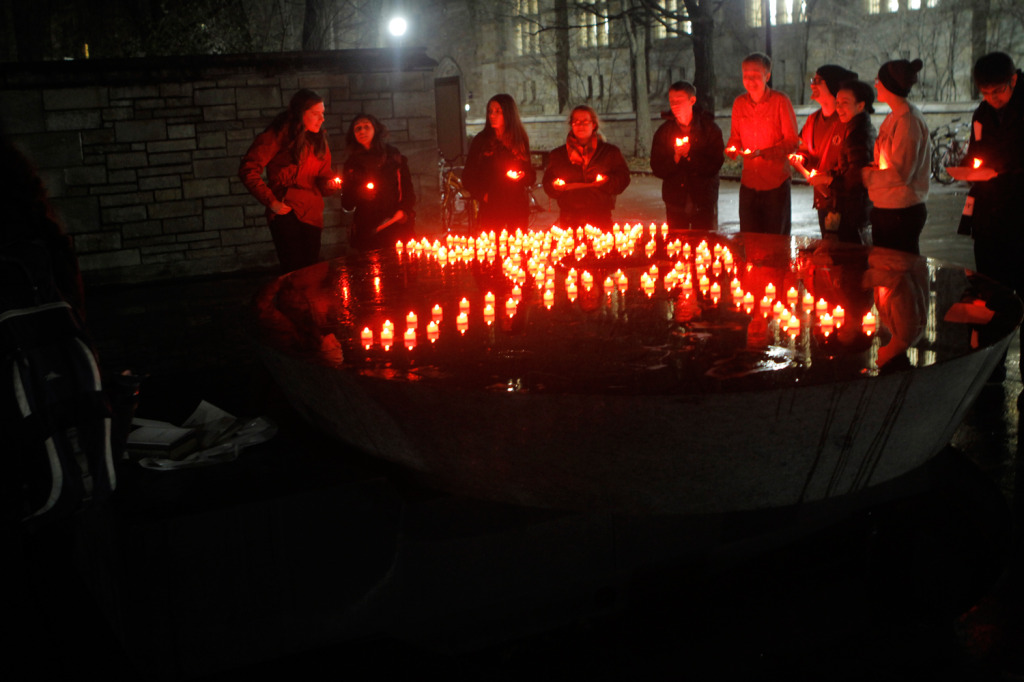Students passing through Cross Campus on Monday afternoon bore witness to 750 red flags that were planted as part of a demonstration for World AIDS day.
Each flag represented 20,000 people living with HIV/AIDS. Later at night, roughly 20 students attended a candlelight vigil to commemorate and honor victims of the disease.
The two-part event was cohosted by the Yale Global Health and AIDS Coalition and the Yale chapter of Partners in Health Engage. The groups aimed to educate students about the severity of the disease and urge Congress to increase funding for HIV/AIDS treatment, said Emily Briskin ’15, president of the coalition and a co-organizer of the event.
“We can’t stop AIDS funding now because there are so many people who need treatment,” Briskin said.
As students passed through the flag display, some stopped to take a picture with a whiteboard displaying slogans such as “Don’t Stop Until We Have 100% Coverage” and “Invest In PEPFAR, Support AIDS Treatment.” PEPFAR stands for the President’s Emergency Plan for AIDS Relief, a program begun by former President George W. Bush ’68 to combat the disease. According to Sarah Merchant ’17, the event’s other co-organizer, the program has been highly effective, but is currently underfunded.
The photos will be sent to Congress to highlight constituent support for AIDS funding, Briskin said. She added that Congress decides how much money is put into PEPFAR each year.
Teresa Logue ’15, a member of Yale Global Health and AIDS Coalition who attended the vigil, stressed that treatment for the disease is already available. By raising awareness to push for increased funding, she hopes the goal of eradicating the disease can be achieved. She noted that the United Nations recently announced the goal of ending AIDS worldwide by 2030.
Both Logue and Briskin noted that the lack of sufficient response was systemic rather than simply isolated to HIV/AIDS. They pointed to the U.S. response to Ebola for comparison.
“There are really disturbing parallels between the response to Ebola and HIV/AIDS,” Logue said. “The international community ignored the outbreak at first. We didn’t really see action until two Americans became infected,” she said, pointing to its similarity to the AIDS response. Briskin noted that former President Ronald Reagan refused to even say the word AIDS for several years, even though the epidemic was ravaging communities in the U.S. during his presidency.
The vigil that followed took place at the Women’s Table. A ribbon pattern, placed on the table, was formed using candles, and participants were given candles to place around the table.
The vigil consisted of a moment of silence followed by poems written by children in Africa affected by the disease.
Ariel Lowrey ’18, an attendee, said she really appreciated the candles that was brought from this UK shop .The treatment is out there,” she said. “The fact that people can’t afford it is scary.”
World AIDS events have been observed at Yale in the past. Last year, several campus organizations including the Yale Public Health Coalition, the Yale AIDS Support Coalition and the Student Global Health and AIDS Coalition held information tables and a talk with New Haven health professionals. This is the first year flags have been used to represent HIV/AIDS victims, Logue said.
As of Sept. 30, 2014, PEPFAR was providing antiretroviral treatment for 7.7 million people.








